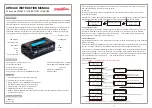
--- 3 ---
6. PRECAUTIONS IN SALES PROMOTION
6-1. Safety Instructions
In the interest of promoting the safest and most efficient use of the Model UC 9SD Charger by all of our
customers, it is very important that at the time of sale the salesperson carefully ensures that the buyer seriously
recognizes the importance of the contents of the Handling Instructions, and fully understands the precautions
listed on the Caution Plate and Nameplate attached to the Charger.
6-1-1. Handling Instructions
Salespersons must be thoroughly familiar with the contents of the Handling Instructions in order to give pertinent
advice to the customer.
(1) Never charge Hitachi 7.2 V rechargeable battery with the Model UC 9SD Charger:
Attempting to charge 7.2 V rechargeable battery can cause the thermal fuse of the Charger transformer or the
electric fuse on the Printed Circuit Board to blow. Strictly avoid charging 7.2 V battery.
(2) Connect the Charger to an AC power outlet only:
Use of any other power source (DC outlet, engine-powered generator, etc.) will cause the Charger to overheat
and burn out.
(3) Do not use any voltage increasing equipment (voltage regulator, etc.) between the power supply and the
Charger:
If the Charger is used with voltage over and above that indicated on the unit, it will not function properly.
(4) Charge at a temperature range of 10 ˚C --- 40 ˚C (50 ˚F --- 104 ˚F):
The Charger and storage batteries each contain a special charging circuit. Be sure to instruct the customer to
charge at a temperature range of 10 ˚C --- 40 ˚C (50 ˚F --- 104 ˚F). In temperatures below 10 ˚C (50 ˚F), even if
the battery is fully charged, the thermostat will not function causing the battery to overcharge dangerously. In
temperatures over 40 ˚C (104 ˚F), batteries will not reach a full charge. The optimum temperature for charging
is around 20 ˚C (68 ˚F) to 25 ˚C (77 ˚F) (room temperature).
(5) Do not use the Charger for repeated charging:
In very hot locations, if two or more batteries are charged successively, the temperature of the Charger may
rise too high and cause the Charger to fail. Instruct the customer to wait for at least 15 minutes before
charging a second battery. Particular care is necessary in summer.
(6) Do not insert foreign objects into the air vents on the Charger:
The Charger case is equipped with air vents to protect the internal electronic components from overheating.
Instruct the customer that foreign materials, such as metallic or flammable objects, are not to be dropped or
inserted into the air vents. This might cause electrical shock, fire or other serious hazards.
(7) Do not attempt to disassemble the Charger:
Incorrect parts replacement and/or wiring will cause malfunctions which could result in fire or other hazards.
Instruct the customer to bring the charger to an authorized service center in the event that repair or
replacement is necessary.
Содержание SV 12SD
Страница 14: ... 12 Assembly Diagram for UC 9SD ...

































